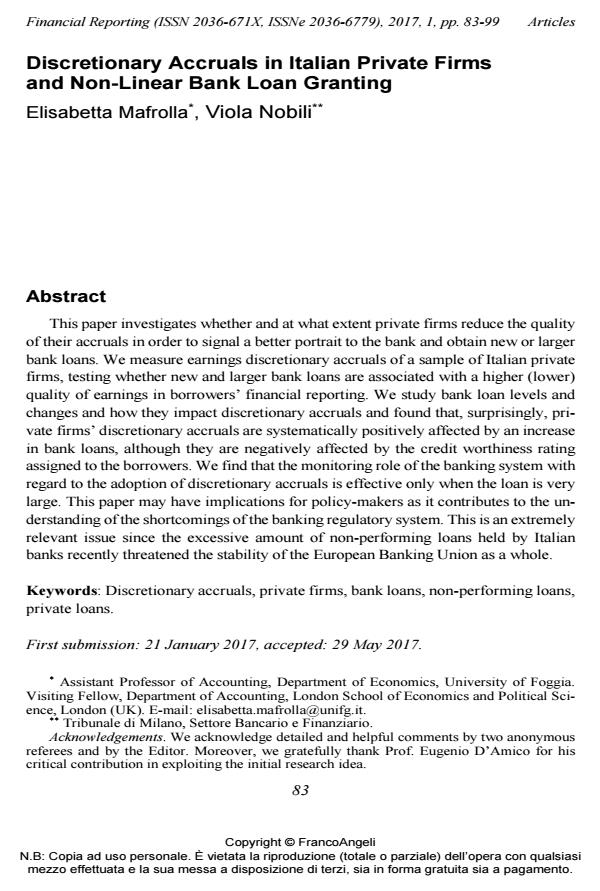Discretionary Accruals in Italian Private Firms and Non-Linear Bank Loan Granting
Journal title FINANCIAL REPORTING
Author/s Elisabetta Mafrolla, Viola Nobili
Publishing Year 2017 Issue 2017/1
Language English Pages 17 P. 83-99 File size 241 KB
DOI 10.3280/FR2017-001004
DOI is like a bar code for intellectual property: to have more infomation
click here
Below, you can see the article first page
If you want to buy this article in PDF format, you can do it, following the instructions to buy download credits

FrancoAngeli is member of Publishers International Linking Association, Inc (PILA), a not-for-profit association which run the CrossRef service enabling links to and from online scholarly content.
This paper investigates whether and at what extent private firms reduce the quality of their accruals in order to signal a better portrait to the bank and obtain new or larger bank loans. We measure earnings discretionary accruals of a sample of Italian private firms, testing whether new and larger bank loans are associated with a higher (lower) quality of earnings in borrowers’ financial reporting. We study bank loan levels and changes and how they impact discretionary accruals and found that, surprisingly, private firms’ discretionary accruals are systematically positively affected by an increase in bank loans, although they are negatively affected by the credit worthiness rating assigned to the borrowers. We find that the monitoring role of the banking system with regard to the adoption of discretionary accruals is effective only when the loan is very large. This paper may have implications for policy-makers as it contributes to the understanding of the shortcomings of the banking regulatory system. This is an extremely relevant issue since the excessive amount of non-performing loans held by Italian banks recently threatened the stability of the European Banking Union as a whole.
Keywords: Discretionary accruals, private firms, bank loans, non-performing loans, private loans.
- The Italian depreciation suspension policy during the COVID-19 pandemic: consequences on private firms’ borrowing capacity Marco Maria Mattei, Matteo Merlo, Eleonora Monaco, in Accounting in Europe /2023 pp.166
DOI: 10.1080/17449480.2023.2174444 - Earnings management incentives: Are they the same for all private firms? Thomas Niederkofler, Lucie Courteau, in FINANCIAL REPORTING 2/2025 pp.123
DOI: 10.3280/fr202519868 - Accrual quality, investor reaction to earnings, and the confirmatory role of sales news Carlo D�Augusta, in FINANCIAL REPORTING 2/2023 pp.97
DOI: 10.3280/FR2023-002004
Elisabetta Mafrolla, Viola Nobili, Discretionary Accruals in Italian Private Firms and Non-Linear Bank Loan Granting in "FINANCIAL REPORTING" 1/2017, pp 83-99, DOI: 10.3280/FR2017-001004